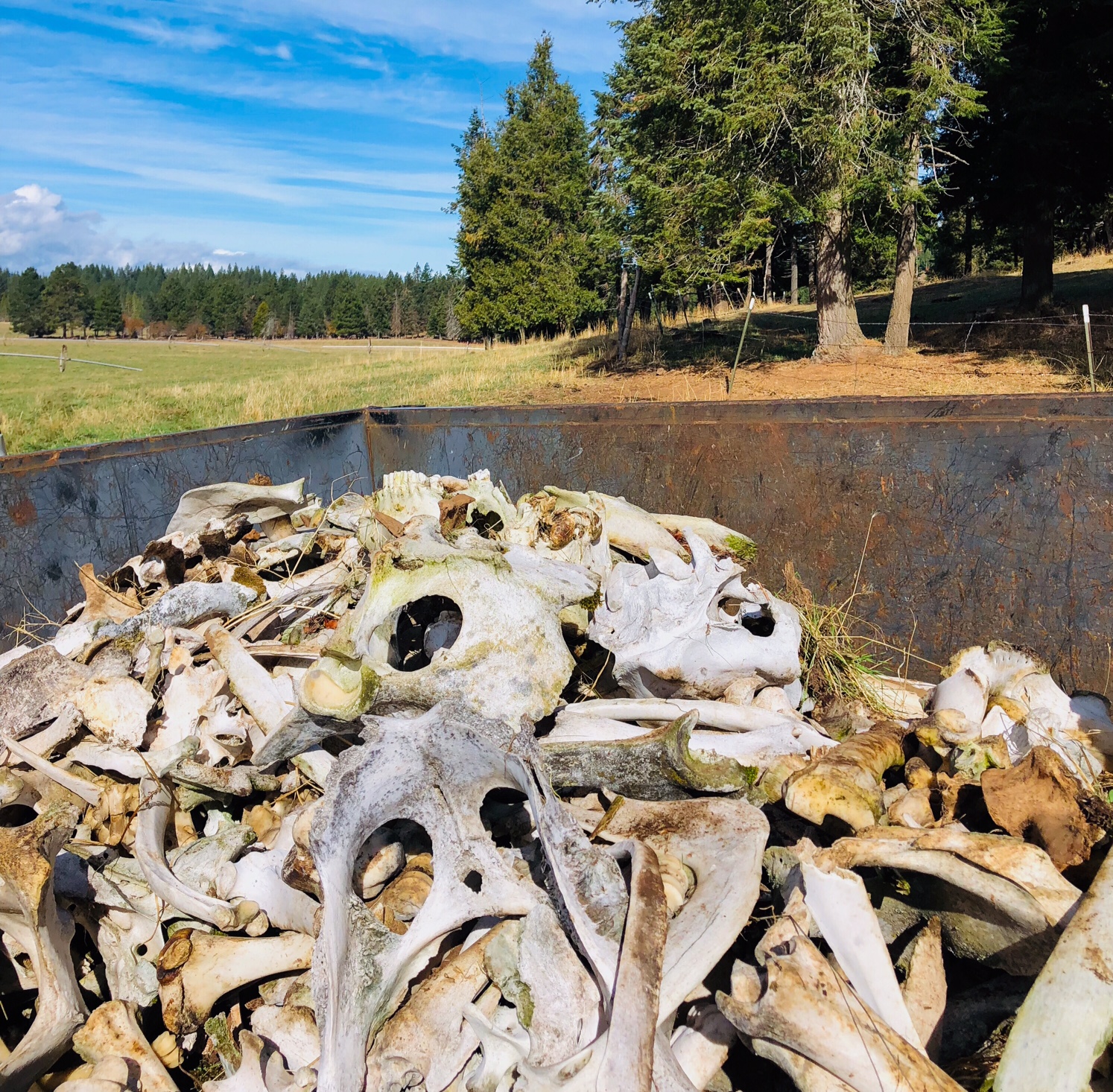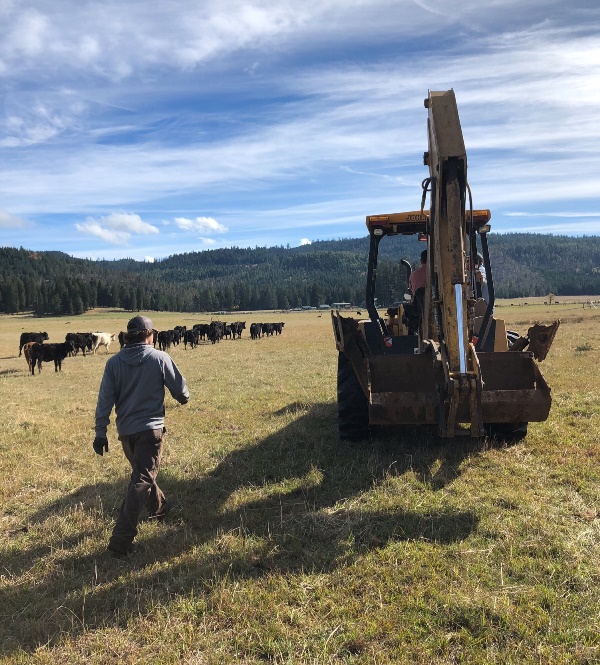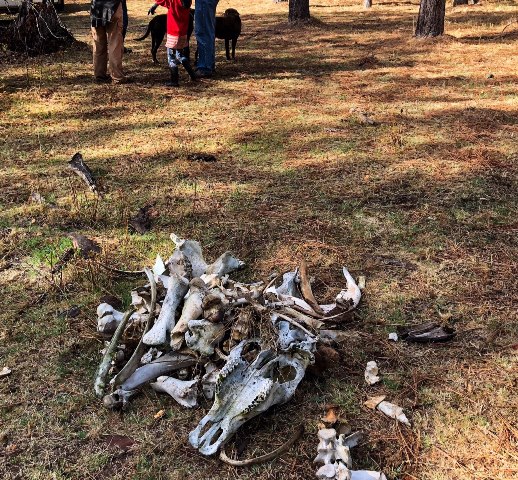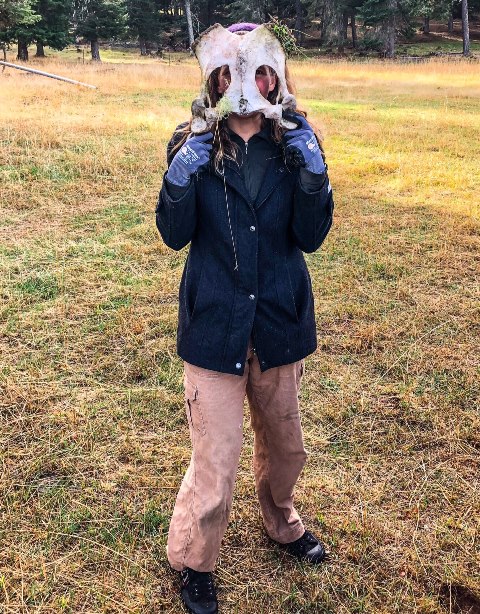
by Alan Hirschmugl
@myoregonimages
Collecting bones wasn’t exactly the project I envisioned getting picked for when I first contacted Oregon Wild about volunteering.
Over the years I had been a supporter and donor to Oregon Wild but had not done any direct volunteer work for the organization. A relocation to the Rogue Valley in 2017 and the chance to explore the area jumpstarted my hiking, backpacking and photography cravings. When I saw the variety of environmental topics and threats that involved the region I decided I wanted to be more involved. Forest fires and the smoke they create, conflict over the Soda Mountain Wilderness, logging pressures and, recently, an active wolf pack in the area, were all topics that concerned me and the areas I was visiting regularly. A couple of emails to Oregon Wild offering to help started the process.
A couple weeks later I received an email from Sean Stevens asking if I would be interested in helping on a project. The exact wording was, “...it is wolf related but it is definitely not your usual volunteer work...”. The warning flags in my mind went up a bit but ANY chance to be involved with wolves was something I would not pass up, since seeing and hearing wolves is pretty much the pinnacle of my outdoors bucket list.
A rancher in southwest Oregon needed help. The Rogue Pack had made the forests and mountains surrounding his place their new home. He had seen many wolves on his property and had suffered losses of cattle and pets. State and federal agencies have been assisting in helping to protect his property in the form of approved hazing methods but there was one project that hadn’t been undertaken...cleaning up “bone piles” that had accumulated on the property over the years before he had moved there.

Anyone who has spent much time in the outdoors knows that bones from dead animal are a common find. Natural death, predation, illness and hunting leaves bones and remains scattered across open land. It is no different for ranchers; over the years, especially on larger operations, it has been common place to leave carcasses where they lie and let the coyotes, turkey vultures and other scavengers take care of the clean-up. Wolves however, have changed that thinking. One “best practice” now is to clean up those bones in the hope that they will be one less attractant to any local wolf population.
A Saturday (appropriately, just before Halloween) was set as the clean-up day. As I drove to the ranch I was a bit apprehensive about the interactions of the other people who would be volunteering, which was to include the rancher and his family, other local ranchers who were friends, a government wildlife biologist and some members of a local outdoors learning center. All were there to help, but each would have a different perspective on the issue. Very few wildlife topics, if any, are as polarizing as wolves and we were going to be working at the physical border of the wolf-human relationship as a group of people who had connections on both side of the issue. What actually transpired was a unique, fun, inspirational day.
 We all arrived at the ranch early in the morning and met near a spot where one of the volunteers was using his backhoe to dig a pit to bury our findings. After some small talk and getting to know each other a bit, we all piled into a large utility-trailer towed behind a pickup truck and drove out to the first clean-up spot, a wooded area where many bones had been seen. The clean-up quickly turned into a bit of a treasure hunt, with each of us simply spreading out and picking up any and all bones we could find. We would carry them to the trailer by the arm loads, toss them in and then head back out for another load. Eventually we developed a system of creating collection points and then pulled the trailer to those spots for loading. A grid-system was organized so that we could cover the ground more thoroughly. Over the next four hours, as we walked and drove across the property, the trailer gradually filled with cow, deer, elk, dog and horse bones.
We all arrived at the ranch early in the morning and met near a spot where one of the volunteers was using his backhoe to dig a pit to bury our findings. After some small talk and getting to know each other a bit, we all piled into a large utility-trailer towed behind a pickup truck and drove out to the first clean-up spot, a wooded area where many bones had been seen. The clean-up quickly turned into a bit of a treasure hunt, with each of us simply spreading out and picking up any and all bones we could find. We would carry them to the trailer by the arm loads, toss them in and then head back out for another load. Eventually we developed a system of creating collection points and then pulled the trailer to those spots for loading. A grid-system was organized so that we could cover the ground more thoroughly. Over the next four hours, as we walked and drove across the property, the trailer gradually filled with cow, deer, elk, dog and horse bones.
 Any especially interesting finds would bring the group together to observe. A small spike deer skull, found by one the of the ranchers children, became a helmet for the young girl. A complete horse skull and massive femur bones from cattle drew amazed comments. The full pelvis bone of a cow was held up as a bizarre mask by one posing volunteer. The children kept searching for the elusive “tongue bone” of a cow. Several of us got picked on for gathering up gray, dried oak branches, thinking that we had found a thin leg bone. One of the most interesting finds, pointed out by Joe Kreuzman, founder and Senior Instructor of the Coyote Trails School of Nature, was a handful (yes, literally a hand full) of skunk scat littered with bee bodies; a quick search nearby produced a spot where the skunk had dug into the ground to eat its way into a bee hive.
Any especially interesting finds would bring the group together to observe. A small spike deer skull, found by one the of the ranchers children, became a helmet for the young girl. A complete horse skull and massive femur bones from cattle drew amazed comments. The full pelvis bone of a cow was held up as a bizarre mask by one posing volunteer. The children kept searching for the elusive “tongue bone” of a cow. Several of us got picked on for gathering up gray, dried oak branches, thinking that we had found a thin leg bone. One of the most interesting finds, pointed out by Joe Kreuzman, founder and Senior Instructor of the Coyote Trails School of Nature, was a handful (yes, literally a hand full) of skunk scat littered with bee bodies; a quick search nearby produced a spot where the skunk had dug into the ground to eat its way into a bee hive.
It started as a clear, crisp day but eventually warmed into the upper 60’s. We were working hard and jackets got removed quickly. Each person probably walked a total of two or three miles. Eventually we covered over 200 acres and, by the owners estimate, cleaned up 95% of the bones on the property. At the end of the day we all moved to the pit and watched, laughed and joked as hundreds of pounds of old bones were dumped in and buried. A group picture was taken. Then we said our good-bye’s and headed out.
It was a unique, productive day and I would do it again in a minute. The main feeling I was left with, however, was the fun people had, the teamwork they displayed and the amount of open discussion about wolves and what their presence in the area means. The landowner shared the complicated (and at times frustrating) dynamic of living with wolves and worrying about impacts to his livelihood. Others could have been outspokenly protective of the wolves and their right to live and hunt the lands they once populated. The actual result, though, was more of a coming-together and a lot of good discussion and story-telling about sightings and experiences with the wolves and the land in general. It was one small event, involving a dozen or so people, done mainly to help one land owner. In the long run, hopefully, it represented what will need to be done on a much larger scale to help all wolves and all rural land owners live together.

